济阳坳陷石炭-二叠系煤系埋藏史与生烃演化
IF 0.5
4区 地球科学
Q4 GEOSCIENCES, MULTIDISCIPLINARY
引用次数: 0
摘要
济阳次盆地石炭-二叠系煤系烃源岩经历了复杂的多期构造,具有复杂的生烃史。由于这些煤系经历了多阶段的埋藏和剥露,具有埋藏深度不同的特点。在本研究中,我们使用盆地建模技术来分析埋藏史与生烃演化之间的关系。重建了C-P煤的埋藏史、热史和成熟史,包括原生生烃史、停滞史、再启动史和峰值次生生烃史。由于深度和生烃延迟的耦合影响,该重建中的次生生烃阶段具有不连续生成和成熟度地理差异的特征。根据成熟度历史和对次生烃生成的延迟效应,得出济阳次盆地次生烃生成门限深度分别发生在燕山期(205Ma~65Ma)的2100m和喜马拉雅期(65Ma~现在)的3200m。根据深度、剩余厚度、成熟度和生烃强度,确定了济阳次盆地五个次生生烃有利区,包括车溪区、古北-罗家区、阳新区、惠民凹陷南坡和东营凹陷西南部。最大VRo/埋藏深度(%/km)发生在印支期,最大VRo//时间(%/100Ma)发生在喜马拉雅期,表明温度和沉降速率对成熟演化的耦合控制在生烃演化中起着重要作用。较高的温度和沉降速率都能促进油气的生成演化。本文章由计算机程序翻译,如有差异,请以英文原文为准。
Burial history and the evolution of hydrocarbon generation in Carboniferous-Permian coal measures within the Jiyang super-depression, China
In the Jiyang Sub-basin, Carboniferous-Permian (C-P) coal-measure source rocks have experienced complex multi-stage tectonics and therefore have a complex history of hydrocarbon generation. Because these coal measures underwent multi-stage burial and exhumation, they are characterized by various burial depths. In this study, we used the basin modeling technique to analyze the relationship between burial history and hydrocarbon generation evolution. The burial, thermal and maturity histories of C-P coals were reconstructed, including primary hydrocarbon generation, stagnation, re-initiation, and peak secondary hydrocarbon generation. The secondary hydrocarbon generation stage within this reconstruction was characterized by discontinuous generation and geographical differences in maturity due to the coupled effects of depth and a delay of hydrocarbon generation. According to the maturity history and the delay effect on secondary hydrocarbon generation, we concluded that the threshold depth of secondary hydrocarbon generation in the Jiyang Sub-basin occurred at 2,100 m during the Yanshan epoch (from 205 Ma to 65 Ma) and at 3,200 m during the Himalayan period (from 65 Ma to present). Based on depth, residual thickness, maturity, and hydrocarbon-generating intensity, five favorable areas of secondary hydrocarbon generation in the Jiyang Sub-basin were identified, including the Chexi areas, Gubei-Luojia areas, Yangxin areas, the southern slope of the Huimin depression and southwest of the Dongying depression. The maximum VRo/burial depth (%/km) occurred in the Indosinian epoch as the maximum VRo/time (%/100Ma) happened in the Himalayan period, indicating that the coupling controls of temperature and subsidence rate on maturation evolution play a significant role in the hydrocarbon generation evolution. A higher temperature and subsidence rate can both enhance the hydrocarbon generation evolution.
求助全文
通过发布文献求助,成功后即可免费获取论文全文。
去求助
来源期刊

Earth Sciences Research Journal
地学-地球科学综合
CiteScore
1.50
自引率
0.00%
发文量
0
审稿时长
>12 weeks
期刊介绍:
ESRJ publishes the results from technical and scientific research on various disciplines of Earth Sciences and its interactions with several engineering applications.
Works will only be considered if not previously published anywhere else. Manuscripts must contain information derived from scientific research projects or technical developments. The ideas expressed by publishing in ESRJ are the sole responsibility of the authors.
We gladly consider manuscripts in the following subject areas:
-Geophysics: Seismology, Seismic Prospecting, Gravimetric, Magnetic and Electrical methods.
-Geology: Volcanology, Tectonics, Neotectonics, Geomorphology, Geochemistry, Geothermal Energy, ---Glaciology, Ore Geology, Environmental Geology, Geological Hazards.
-Geodesy: Geodynamics, GPS measurements applied to geological and geophysical problems.
-Basic Sciences and Computer Science applied to Geology and Geophysics.
-Meteorology and Atmospheric Sciences.
-Oceanography.
-Planetary Sciences.
-Engineering: Earthquake Engineering and Seismology Engineering, Geological Engineering, Geotechnics.
 求助内容:
求助内容: 应助结果提醒方式:
应助结果提醒方式:


